A new method for in vitro feeding of Rhipicephalus australis (formerly Rhipicephalus microplus) larvae: a valuable tool for tick vaccine development
- PMID: 28335800
- PMCID: PMC5364646
- DOI: 10.1186/s13071-017-2081-0
A new method for in vitro feeding of Rhipicephalus australis (formerly Rhipicephalus microplus) larvae: a valuable tool for tick vaccine development
Abstract
Background: Rhipicephalus microplus is a hard tick that has a major impact on cattle health in tropical and subtropical regions because it feeds on cattle and is implicated in the transmission of pathogens that cause diseases such as bovine anaplasmosis and babesiosis. Presently, acaricides are used to control tick infestation but this is becoming increasingly less effective due to the emergence of tick strains that are resistant to one or more classes of acaricides. Anti-tick vaccines are a promising alternative to control tick infestation in cattle. The life-cycle and host preference of R. microplus, however, makes vaccine research in cattle costly and would therefore greatly benefit from an in vitro screening system.
Methods: To this aim, a stacked 24-well in vitro feeding system was designed in which the blood meal was administered in a chamber on top of the compartment containing the ticks, exploiting their anti-gravitational tendency. Both compartments were separated by a special feeding membrane, which was made by applying a silicone mixture to a gold beater's skin (baudruche membrane) with a paint roller to create a slightly uneven surface of 17-40 μm variable thickness. To further stimulate feeding, the membrane was treated with bovine hair extract and the unit was placed at 37 °C with 90% RH and 5% CO2.
Results: Using this set-up with Rhipicephalus australis (formerly Rhipicephalus microplus), a larval engorgement rate of up to 71% could be achieved. The larvae could successfully feed on blood, but also on serum. The latter allows easy screening of the effect of sera that are raised against tick proteins on feeding. As an example, serum from cattle that were vaccinated with the Bm86 midgut protein of R. microplus significantly reduced larval engorgement rates by 42%.
Conclusion: The in vitro feeding system's high throughput design and its ability to measure statistically significant anti-tick effects in sera from immunized cattle enables screening of multiple vaccine candidates in a cost-effective manner.
Keywords: Artificial tick feeding; In vitro screening; Larvae; Rhipicephalus australis; Rhipicephalus microplus.
Figures

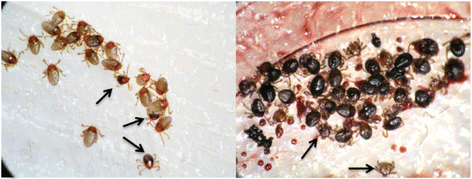
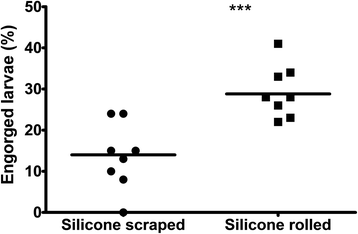
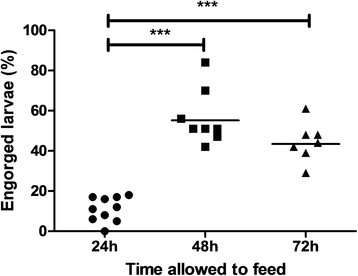
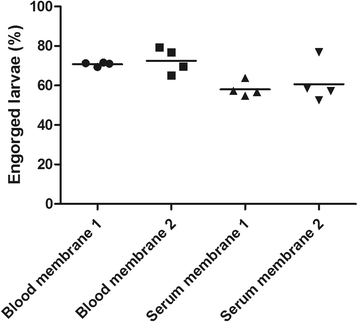

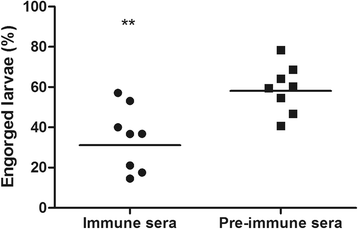
Similar articles
-
A combination of antibodies against Bm86 and Subolesin inhibits engorgement of Rhipicephalus australis (formerly Rhipicephalus microplus) larvae in vitro.Parasit Vectors. 2019 Jul 25;12(1):362. doi: 10.1186/s13071-019-3616-3. Parasit Vectors. 2019. PMID: 31345265 Free PMC article.
-
Rhipicephalus (Boophilus) microplus tick in vitro feeding methods for functional (dsRNA) and vaccine candidate (antibody) screening.Ticks Tick Borne Dis. 2014 Sep;5(5):500-10. doi: 10.1016/j.ttbdis.2014.03.005. Epub 2014 May 27. Ticks Tick Borne Dis. 2014. PMID: 24875450
-
Lesser protein degradation machinery correlates with higher BM86 tick vaccine efficacy in Rhipicephalus annulatus when compared to Rhipicephalus microplus.Vaccine. 2013 Oct 1;31(42):4728-35. doi: 10.1016/j.vaccine.2013.08.031. Epub 2013 Aug 22. Vaccine. 2013. PMID: 23973246
-
Immunological control of ticks and tick-borne diseases that impact cattle health and production.Front Biosci (Landmark Ed). 2018 Mar 1;23(8):1535-1551. doi: 10.2741/4659. Front Biosci (Landmark Ed). 2018. PMID: 29293449 Review.
-
A review of the history of research and control of Rhipicephalus (Boophilus) microplus, babesiosis and anaplasmosis in Uruguay.Exp Appl Acarol. 2018 Aug;75(4):383-398. doi: 10.1007/s10493-018-0278-3. Epub 2018 Aug 6. Exp Appl Acarol. 2018. PMID: 30083875 Review.
Cited by
-
In vitro feeding of all life stages of two-host Hyalomma excavatum and Hyalomma scupense and three-host Hyalomma dromedarii ticks.Sci Rep. 2024 Jan 3;14(1):444. doi: 10.1038/s41598-023-51052-w. Sci Rep. 2024. PMID: 38172407 Free PMC article.
-
Evaluation of a semi-automated in vitro feeding system for Dermacentor reticulatus and Ixodes ricinus adults.Parasitol Res. 2018 Feb;117(2):565-570. doi: 10.1007/s00436-017-5648-y. Epub 2018 Jan 3. Parasitol Res. 2018. PMID: 29297094 Free PMC article.
-
Unravelling the cellular and molecular pathogenesis of bovine babesiosis: is the sky the limit?Int J Parasitol. 2019 Feb;49(2):183-197. doi: 10.1016/j.ijpara.2018.11.002. Epub 2019 Jan 26. Int J Parasitol. 2019. PMID: 30690089 Free PMC article. Review.
-
A combination of antibodies against Bm86 and Subolesin inhibits engorgement of Rhipicephalus australis (formerly Rhipicephalus microplus) larvae in vitro.Parasit Vectors. 2019 Jul 25;12(1):362. doi: 10.1186/s13071-019-3616-3. Parasit Vectors. 2019. PMID: 31345265 Free PMC article.
-
Optimization of artificial membrane feeding system for lone star ticks, Amblyomma americanum (Acari: Ixodidae), and experimental infection with Rickettsia amblyommatis (Rickettsiales: Rickettsiaceae).J Med Entomol. 2024 Mar 13;61(2):442-453. doi: 10.1093/jme/tjad158. J Med Entomol. 2024. PMID: 38104248 Free PMC article.
References
MeSH terms
LinkOut - more resources
Full Text Sources
Other Literature Sources
Research Materials

